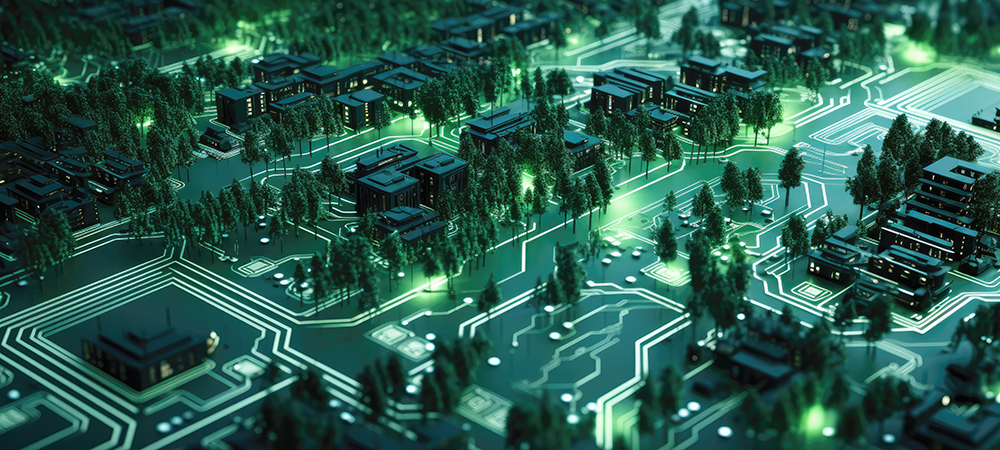Given that microgrids are miniature versions of existing, monolithic grid system, there is speculation on how they can be differentiators in the drive to sustainability, and the answer boils down to efficiency of decentralisation and the energy mix used, explains Carol Johnston at IFS.
Keeping pace with technological advances is just the beginning for energy, utilities, and resources, energy, utilities, resources organisations. They must now consider the survival of the planet and the people who live on it. The timeline to net-zero is only getting shorter, so the hunt is on for new and innovative methods to improve sustainability.
Although an ever-shortening sustainability timeline puts immense pressure on organisations, it has accelerated the pace of innovation, delivering ideas and opportunities that were unheard of only a few short years ago. It has given rise to the use of microgrids, miniature versions of the traditional grid where power supply and distribution first began.
Microgrid landscape
In 2022, North America led the microgrid charge, accounting for more than 35% of overall global microgrid revenue share, despite currently only providing less than 0.3% of US electricity. There is a long way to go but microgrids have grown 11% in capacity in the last four years and, there are over 460 operational microgrids in the US that provide 3.1 gigawatts of reliable electricity to the communities they serve.
In the transition to a low-carbon economy, microgrids are now an attractive prospect with their ability to incorporate renewable energies, and survive natural weather disasters, helping keep lights on, countries in power, and consumers unaffected.
The global microgrid market is now set to increase exponentially, as developing countries turn to microgrids to tackle crucial energy challenges. In 2022, the global microgrid market size was valued at $54.4 billion, and is expected to grow at a compound annual growth rate, CAGR of 16.3% from 2023 to 2030.
From reducing energy waste and system-wide blackouts, to protecting workers, and the environment they work within, microgrids have the potential to transform how the globe sources, distributes, and consumes energy:
Replacing monolithic grids
Given that microgrids are simply miniature versions of our existing, monolithic grid system, there is much speculation on how they can be such a differentiator in the drive to sustainability. The answer boils down to the efficiency of decentralisation, and the energy mix used in microgrids.
A traditional grid, due to its consolidated design, is incredibly inefficient, and results in a significant amount of energy wastage. By its very nature, moving electricity via transmission lines is not an efficient practice. Take the US as an example. In 2022, US utility-scale electricity facilities generated 4.24 trillion kilowatt-hours, kWh. With a national average electricity rate of 23 cents per kWh, we are throwing away over $48 billion of energy every year.
In comparison, microgrids generate and distribute energy locally. With no need to transmit over long distances, energy loss is mitigated and its back-up capability ensures that if the supply of energy is intermittent, for example, cloudy or wind-free conditions, excess energy stored in batteries serves as an independent back-up.
Additionally, microgrids work with all sources of energy. Along with more common options such as solar and wind, other sources such as hydrogen and tidal also support the model, so for sustainability reasons alone, it is clear to see why more energy, utilities, resources organisations are turning to microgrid deployment.

De-energising aging grids
In part due to climate change, extreme weather conditions across the US are becoming more common. Now combined with an aging energy grid and increased demand, blackouts are part of living within the US. On average, US electricity customers experienced just over eight hours of electric power interruptions in 2020.
As a result, it has given rise to increased occurrences of controversial preventative de-energising, where the power of energy lines is shut off to prevent fires, during high winds for example, and reactive outages as a result of damage to infrastructure.
The current issue stems from monolithic energy grids that have been built connectively. As the people of Texas discovered in the winter of 2021, when individual components fail, so does the grid.
In such circumstances, technology that is flexible, agile, and responsive will provide invaluable support, and it is where microgrids, a composable system that allows systems to be assembled from smaller, independent components will prove its worth in building resilience into the energy network.

Advantages of micro grids
Microgrids are independent of larger systems. Their ability to disconnect from the traditional grid to operate autonomously and locally, ensures that if a microgrid fails, even if it is one of many microgrids feeding a larger model, the impact is limited to the local area of service. Fail-safe and redundancy measures are easily implemented by simply building multiple microgrids to ensure continuous access to energy.
The ability to produce and store energy locally has really taken off, with new use cases for microgrids on the rise. In Neenah, Wisconsin, Bergstrom Automotive is implementing off-grid microgrid units powered by solar, with support from an on-site natural gas generator. The system will provide a clean energy infrastructure solution to charge EVs. These early advances are just a precursor to the full potential of microgrids.
The promise of microgrids to improve sustainability and reduce blackouts are clear to see, but the advantages of a decentralised grid still go one step further.
Traditional grids are vast. Transmission lines regularly cover thousands of miles that will need regular maintenance and repair infrastructure checks. Among operating in a risky environment, pressure is on the employees who must travel long distances, often in remote locations, to do perilous work.
As inclement weather causes lines to fall down and contact between ground vegetation and a downed high-voltage conductor can often spark fires, worker injuries are common and response times are usually delayed.
Here, microgrids provide the perfect solution as they do not distribute energy over long distances. Maintenance and repairs are conducted locally, while environmental conditions are managed in the moment.

Energy provider to service provider
To make a decentralised grid a success, energy, utilities, resources companies will need to rethink their primary role within society. In fact, energy, utilities, resources organisations will shift from their role as energy providers to become service providers. As domain experts, energy, utilities, resources organisations must implement a more flexible business model where they trade on their expertise in energy production, storage, and distribution.
For some, these changes are already underway. For example, Colorado Springs Utilities recently entered into an agreement with Duke Energy to build a new solar plant in El Paso County, reducing energy costs while providing diverse and cleaner energy solutions for its customers.
The rapid development of microgrids is a positive and exciting step towards sustainability, and the Colorado Springs use case is a perfect example of how traditional and contemporary grid models must work in concert.
It is all change for energy, utilities, resources: microgrids are the next big step to a sustainable future
Microgrids herald an amazing step forward in how we power our planet, and ultimately our lives, directly impacting the future of the energy, utilities, resources industry. The change over to microgrids will not be a quick fix, but the sustainability and availability benefits, alongside improved worker and environment safety are definitely worth the long-haul work to make microgrids a success.
With a competitive industry solution to support microgrids, the entire asset lifecycle is supported. IFS Cloud combines a flexible, native enterprise asset management, EAM, field service management, FSM, and enterprise resource planning, ERP solution tailored to the needs of microgrids. In doing so, energy, utilities, resources companies can ensure complete control of operations, whilst optimising asset performance and safety.



